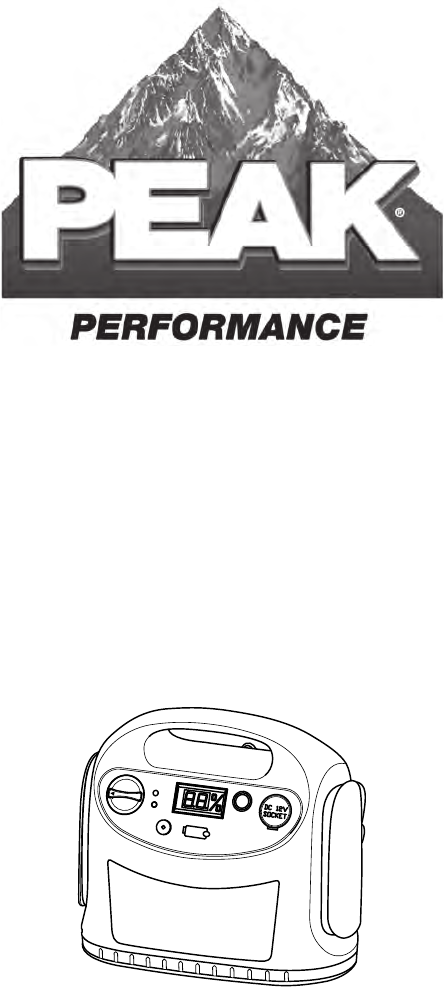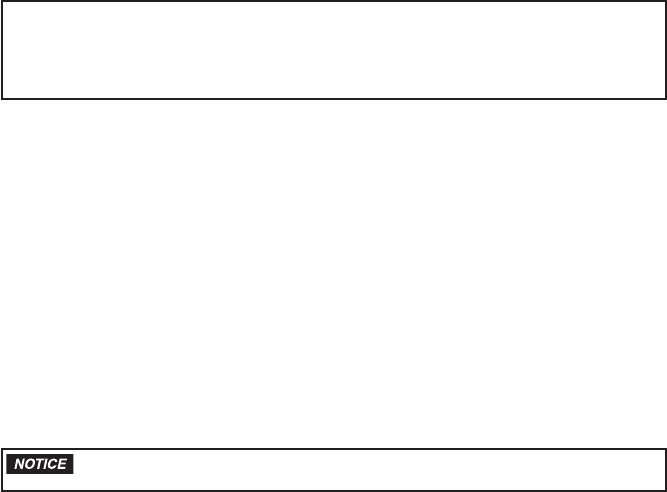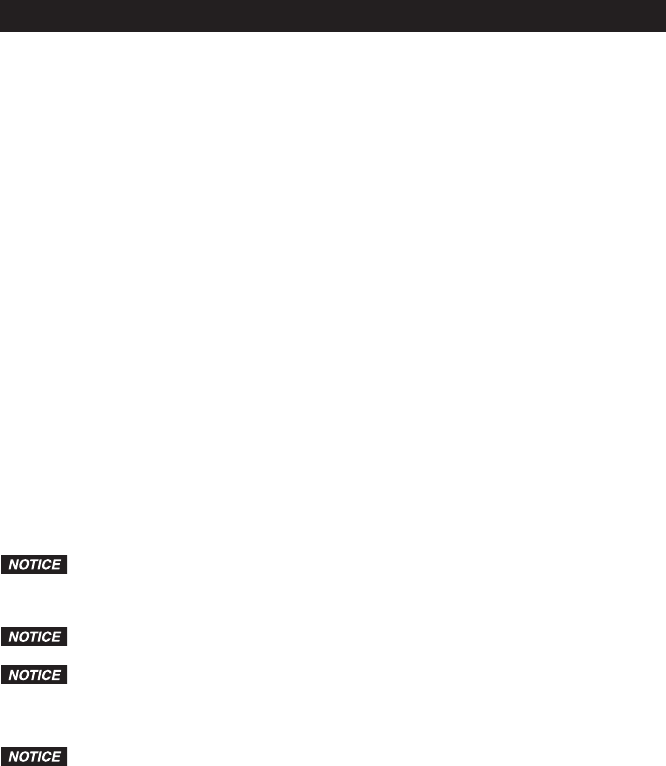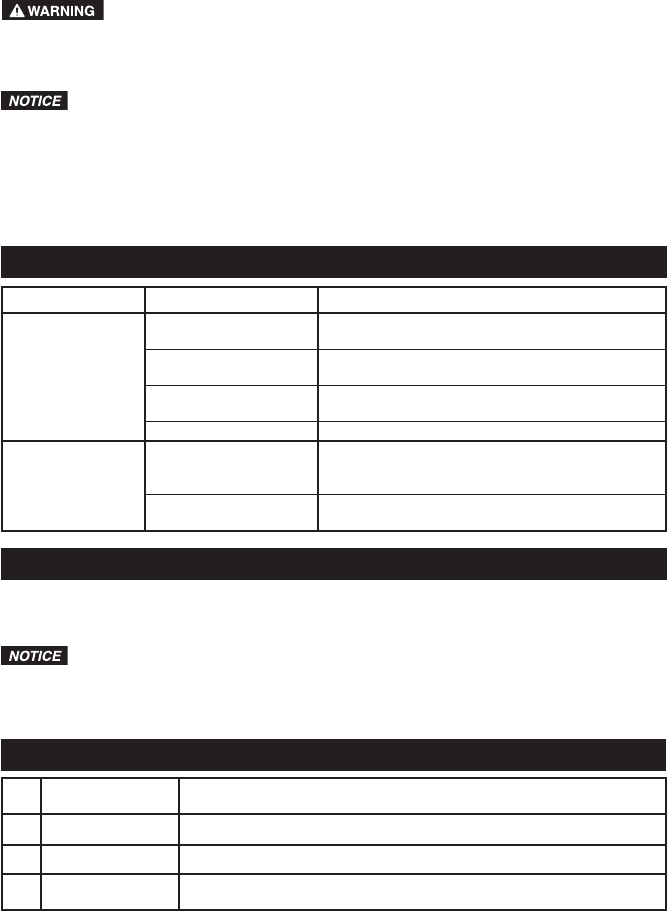
600 Peak
Amp
Jump-Starter
Model No.: PKC0J6
Owner
’s Manual
and W
arranty Information
Read these instructions completely before using this product.
Retain this Owner
’s Manual for future reference.

Do not e
xpose battery to
fi
re or intense heat since it can explode.
Be
fore recycling or disposing of a battery, protect exposed terminals with heavy-duty electrical tape
to pr
event shorting (shorting can result in personal injury or
fi r
e).
Alw
ays wear protective eyewear when using this product. Contact with battery acid can cause
blindness and/or se
vere chemical burns.
F
ollow these
fi
rst aid procedures in case of accidental contact with battery acid.
FIR
ST AID
SKIN: Wash skin thoroughly if battery acid comes in contact with skin. Seek medical attention
immediately
.
EYES:
Flush eyes with cool water for at least ten minutes. Seek medical attention immediately.
CONTACT POISON CONTROL CENTER IMMEDIATELY IF INGESTED.
Ne
ver touch battery clamps together or to a common piece of metal. Sparking, explosion or
damage to the unit can result. Always store the battery clamps on the appropriate case clamp posts
on the back of the unit after use
.
Place this unit as f
ar away from the battery being charged as the charging cables will permit.
When using the Jump-Star
ter close to the vehicle’s battery and engine, place the unit on a
fl at,
stable sur
face, and keep all clamps, cords, clothing and body parts away from moving parts of the
v
ehicle.
F
ollow these instructions and those published by the battery manufacturer and manufacturer of
an
y equipment you intend to use near the battery. Pay attention to all hazard precautions on these
pr
oducts and on the engine before charging.
This s
ystem is designed to be used only on vehicles with a 12-volt DC battery system. Do
not
connect to a 6-volt or 24-volt battery system.
R
emove all jewelry or metal objects that could cause short circuits or react with battery acid. A lead-
acid batter
y produces a short-circuit current high enough to weld a ring or other similar objects to
metal, causing a se
vere burn.
When w
orking on electrical equipment, always ensure someone is nearby to help you in an
emer
gency.
K
eep a supply of baking soda on hand when working on batteries. Baking soda neutralizes lead-
acid batter
y electrolyte.
All messages that f
ollow have NOTICE level hazards. Failure to comply could
r
esult in property damage.
V
ehicles that have on-board computerized systems may be damaged if vehicle battery is jump-
star
ted. Before jump-starting, read the vehicle’s owner’s manual to con
fi
rm that external-starting
assistance is suitable.
Ex
cessive engine cranking can damage a vehicle’s starter motor. If the engine fails to start after
the r
ecommended number of attempts, discontinue these jump-start procedures and look for other
pr
oblems that may need to be corrected.
This Jump-Star
ter is
not designed to be used as a r
eplacement for a vehicle’s battery. Do
not
attempt to oper
ate a vehicle that does not have a battery installed.
After connecting the batter
y charging clamps to the discharged battery and before turning on the
jump-star
ter ON/OFF switch, check the power/polarity indicator light on the front of the unit. If the
light is GREEN, the clamp connections ar
e correct. If the light is RED and an alarm sounds, the
clamp connections ar
e incorrect and need to be reversed.
This Jump-Starter is delivered in a partially charged state. Fully charge unit with the supplied
110/120-v
olt AC charger to the recommended maximum and initial charge time of 24 hours.
Ther
eafter, an AC typical charge time is 8 to 12 hours when using the AC charger.
Although this unit contains a sealed batter
y, it is recommended that unit be kept upright during
stor
age, use and recharging. To avoid possible damage that may shorten the unit’s working life,
pr
otect it from direct sunlight, direct heat and/or moisture.
Ne
ver allow battery acid to come in contact with this unit.
All ON/OFF s
witches should be in the OFF position when charging the Jump-Starter or when not in
use
. Make sure all switches are in the OFF position before connecting to a power source or load.
Do not use an
y accessory that is not recommended or provided by the manufacturer.

INTR
ODUCTION
This Jump-Star
ter has been carefully engineered and manufactured to give you dependable operation.
Please r
ead this manual thoroughly before operating your new Jump-Starter, as it contains the
inf
ormation you need to become familiar with its features and obtain the performance that will bring you
continued enjo
yment for many years. Please keep this manual on
fi
le for future reference.
FEA
TURES
Built-in 600 peak amps batter
y jump-starter with quick storing cables and clamps
Built-in 12-v
olt DC power socket for powering DC appliances
Built-in USB po
wer outlet
Batter
y indicator display (indicates % of charge)
R
everse polarity connection LED indicator with sound alarm
Includes sealed, maintenance-fr
ee, heavy-duty, lead-acid battery
R
equires no maintenance (other than recharging) for optimal operation
110/120-v
olt AC charging plug
Saf
e to use, transport and store
Molded high-impact case is tough and durable
L
ow Charge Alert (LCA)™
1
2
3
4
5
6
9
11
12
8
7
10
Leg
end
1. Jump-Starter/USB Port ON/OFF
Switch
2.
Jump-Starter/USB Port ON LED
3.
Battery Indicator Display
4.
Display Button
5.
12-volt DC Power Socket
6.
USB Port
7.
Low Charge Alert (LCA) Port
8.
Reverse Polarity Indicator LED
9.
Low Charge Alert (LCA) Storage
Port
10.
110/120-volt AC Charging Plug
11.
Red Positive (+) Jumper Cable
12.
Black Negative (-) Jumper Cable
Lo
w Charge Alert and LCA are trademarks of Old World Industries, LLC. Used with permission. All rights
reser
ved.

OPERATION
Checking Jump-Star
ter Battery Status
Pr
ess and hold the battery status button, located on the front of the unit, to check the Jump-Starter
batter
y charge level. The battery indicator display will indicate battery charge state as a percentage of
the full batter
y capacity.
L
ow Charge Alert (LCA)
On the front of the unit there is a Low Charge Alert port. There is a red plug in this port. With the plug
r
emoved, when the battery level drops to LO, an alarm will sound to remind the user to recharge the
Jump-Star
ter.
The alarm can be turned off
one of three ways:
Placing the pin bac
k into the Low Charge Alert port
Recharging the batter
y immediately to bring it to the capacity of 10% or more
Pressing the batter
y indicator display button. If the alarm is turned off by pressing the battery
displa
y button, the alarm will sound automatically again in approximately 1 hour.
The alarm will only be turned off
permanently if the battery is in a fully charged state, or the pin is
inser
ted in the Low Charge Alert port. There is a storage port on the back of the Jump-Starter for the
LCA plug. When the plug is removed from the LCA port, it should be installed in the storage port on the
back of the Jump-Star
ter.
Char
ging Jump-Starter Battery
All rechargeable batteries gradually discharge when left idle, and you need to recharge them
periodically to maintain maximum batter
y capacity. The AC charger plug within the Jump-Starter is
designed to char
ge using a 110/120-volt outlet.
F
ully charge unit to the recommended maximum and initial charge time of 24 hours. Thereafter, an
A
C typical charge time is 8 to 12 hours.
R
echarge the unit fully after each use. This will prolong the life of the battery because frequent
dischar
ges between recharges will reduce battery life.
Mak
e sure all functions of the Jump-Starter are turned o
ff
during recharging.
Due to inher
ent self-discharge, lead-acid batteries should be charged at least every
4 months, especially in a warm environment. Leaving a battery in a discharged state, or if not
r
echarged every 4 months, may result in permanent battery damage and poor jump-starting
per
formance.
Do not attempt to recharge the Jump-Starter battery if it is frozen. Gradually warm
the fr
ozen battery to 0°C (32°F) before recharging.
Do not oper
ate DC appliances with the Jump-Starter while the unit is being
r
echarged with the AC charger. The AC charger may be permanently damaged if 12-volt DC
appliances ar
e operated while the AC charger is connected.
110/120-
Volt AC Charging
DO NO
T EXCEED MAXIMUM RECOMMENDED AC CHARGE OF 24 HOURS.
1.
Disconnect any DC appliance from the 12-volt DC power socket.
2.
Turn all ON/OFF switches to the OFF position.
3.
Only charge the
Jump-Star
ter
using an appr
oved external AC power cord.
4.
Flip out the AC charging plug from the back of the
Jump-Star
ter
.
5.
Connect the extension plug to the AC charging plug.
6.
Plug the extension cord into a 110/120-volt AC outlet. The battery indicator display will gradually
incr
ease as the
Jump-Star
ter
is char
ging.
7.
When the Jump-Starter is fully charged, the display will read FL. Disconnect the AC extension
cor
d from the 110/120-volt AC outlet, and then disconnect it from the
Jump-Star
ter
A
C charging
plug.

Jump-Star
ting (Negative Ground Systems Only)
This Jump-Star
ter is equipped with a manual jump-starter/USB ON/OFF switch. Before turning this
switch on, check the power/polarity indicator after both jump-start cable clamps have been connected. If
the light is RED and an alarm sounds
, the clamp connections are incorrect and need to be reversed. If
the light is GREEN, the clamp connections ar
e correct. When the jump-start cable clamps are connected
and the po
wer/polarity indicator is lit green, it is safe to turn the jump-starter ON/OFF switch to ON.
EXPL
OSION HAZARD
Ne
ver allow the jump-start cable clamps (red and black) to touch each other or another
common metal conductor
. This could cause damage to the unit and/or create a sparking/
e
xplosion hazard. Always switch o
ff
the jump-starter ON/OFF switch and store the jump-start
clamps on the appr
opriate case clamp posts on the back of the unit after use.
EXPLOSION HAZARD
Jump-star
t cable clamp connections at the vehicle’s battery terminals must be positive to
positiv
e (red clamp to battery “+”) and negative (black clamp) to the grounding point such as
the metal fr
ame of the vehicle. A reverse polarity connection (positive to negative) may cause
damage to the unit and/or cr
eate a sparking/explosion hazard.
1.
Turn o
ff
ignition and all vehicle accessories.
2. Make sure the Jump-Starter is fully charged and jump-starter/USB ON/OFF switch is in the OFF
position.
Turn any additional functions of your Jump-Starter o
ff .
3.
Check your vehicle’s owners manual for proper jump-starting procedure. Many newer vehicles
ha
ve a separate location for jump-starting, away from the battery. Always use the vehicle
manuf
acturer’s recommended procedure.
4.
Securely connect the red positive (+) cable to the vehicle’s positive (+) jumping terminal.
5.
Connect the black negative (-) cable to a non-moving metal part on the vehicle. Do not connect
to the negativ
e (-) battery terminal. Make sure the red reverse polarity light is not on. If it is on,
the Jump-Star
ter is not installed correctly. Immediately stop and recheck your connections. Only
continue if the gr
een polarity indicator is lit.
6. If the green polarity indicator is lit, the Jump-Starter battery indicator display will show the charge
le
vel of the battery to be jump-started. If there is no display, recheck your connections. If the
batter
y for the vehicle is completely discharged, you will not be able to use the Jump-Starter. You
ma
y be required to charge the battery before jump-starting.
7.
After verifying that connections are correct, turn the jump-starter/USB ON/OFF switch to the ON
position.
After the jump-starter/USB
ON/OFF switch is in the ON position, the battery indicator
displa
y will show a reading for the combined battery capacity of the Jump-Starter and the car
batter
y. If there is no reading, or the display reading shows LO, the car battery may be dead and
cannot be jump-star
ted.
8.
Crank the engine in 5- to 6-second bursts.
Do not cr
ank the engine for more than 6 seconds. The jump-start feature is
designed for short-term operation only. Operating the jump-start feature for more than 6
seconds ma
y cause damage to the unit. Allow the Jump-Starter to cool down for at least 3
minutes after each jump-star
t.
9. Once engine has started, TURN THE JUMP-STARTER ON/OFF SWITCH TO THE OFF
POSITION AND DISCONNE
CT THE BLACK NEGATIVE CLAMP FIRST
and then the r
ed
positiv
e clamp.
10.
Recharge the Jump-Starter as soon as possible after each use.
DC P
ower Socket Operation
This Jump-Star
ter is equipped with a 12-volt DC power socket. It can operate 12-volt DC automobile,
R
V, marine or other portable appliances that draw less than a total of 10 amps from a 12-volt DC power
sock
et or from a vehicle’s cigarette lighter/accessory socket.
Oper
ating a DC Device
1. Remove the protective cover from the DC power socket.
2.
Plug the 12-volt DC appliance into the power
sock
et
.
3.
Turn on the 12V DC Power ON/OFF switch, then turn the appliance on (if required).
If the appliance draws more than 10 amps (or has a short-circuit defect), the internal circuit breaker
of the Jump-Star
ter shuts o
ff
the power to the appliance. If this occurs, unplug the appliance. The
internal cir
cuit breaker automatically resets after a few seconds.
4.
Fully recharge the Jump-Starter as soon as possible after each use. As the DC power
sock
et
is
internally wir
ed directly to the Jump-Starter’s battery, extended operation of a 12-volt DC appliance
ma
y result in excessive battery discharge.
Note:
At full charge, the Jump-Starter should power a black-and-white TV or spotlight for 4 hours,
a mini cooler f
or 3 hours, or a portable vacuum cleaner or co
ff
ee maker for up to 1 hour.
Application times ar
e estimates only.

Jump-Star
ting (Negative Ground Systems Only)
This Jump-Star
ter is equipped with a manual jump-starter/USB ON/OFF switch. Before turning this
switch on, check the power/polarity indicator after both jump-start cable clamps have been connected. If
the light is RED and an alarm sounds
, the clamp connections are incorrect and need to be reversed. If
the light is GREEN, the clamp connections ar
e correct. When the jump-start cable clamps are connected
and the po
wer/polarity indicator is lit green, it is safe to turn the jump-starter ON/OFF switch to ON.
EXPL
OSION HAZARD
Ne
ver allow the jump-start cable clamps (red and black) to touch each other or another
common metal conductor
. This could cause damage to the unit and/or create a sparking/
e
xplosion hazard. Always switch o
ff
the jump-starter ON/OFF switch and store the jump-start
clamps on the appr
opriate case clamp posts on the back of the unit after use.
EXPLOSION HAZARD
Jump-star
t cable clamp connections at the vehicle’s battery terminals must be positive to
positiv
e (red clamp to battery “+”) and negative (black clamp) to the grounding point such as
the metal fr
ame of the vehicle. A reverse polarity connection (positive to negative) may cause
damage to the unit and/or cr
eate a sparking/explosion hazard.
1.
Turn o
ff
ignition and all vehicle accessories.
2. Make sure the Jump-Starter is fully charged and jump-starter/USB ON/OFF switch is in the OFF
position.
Turn any additional functions of your Jump-Starter o
ff .
3.
Check your vehicle’s owners manual for proper jump-starting procedure. Many newer vehicles
ha
ve a separate location for jump-starting, away from the battery. Always use the vehicle
manuf
acturer’s recommended procedure.
4.
Securely connect the red positive (+) cable to the vehicle’s positive (+) jumping terminal.
5.
Connect the black negative (-) cable to a non-moving metal part on the vehicle. Do not connect
to the negativ
e (-) battery terminal. Make sure the red reverse polarity light is not on. If it is on,
the Jump-Star
ter is not installed correctly. Immediately stop and recheck your connections. Only
continue if the gr
een polarity indicator is lit.
6. If the green polarity indicator is lit, the Jump-Starter battery indicator display will show the charge
le
vel of the battery to be jump-started. If there is no display, recheck your connections. If the
batter
y for the vehicle is completely discharged, you will not be able to use the Jump-Starter. You
ma
y be required to charge the battery before jump-starting.
7.
After verifying that connections are correct, turn the jump-starter/USB ON/OFF switch to the ON
position.
After the jump-starter/USB
ON/OFF switch is in the ON position, the battery indicator
displa
y will show a reading for the combined battery capacity of the Jump-Starter and the car
batter
y. If there is no reading, or the display reading shows LO, the car battery may be dead and
cannot be jump-star
ted.
8.
Crank the engine in 5- to 6-second bursts.
Do not cr
ank the engine for more than 6 seconds. The jump-start feature is
designed for short-term operation only. Operating the jump-start feature for more than 6
seconds ma
y cause damage to the unit. Allow the Jump-Starter to cool down for at least 3
minutes after each jump-star
t.
9. Once engine has started, TURN THE JUMP-STARTER ON/OFF SWITCH TO THE OFF
POSITION AND DISCONNE
CT THE BLACK NEGATIVE CLAMP FIRST
and then the r
ed
positiv
e clamp.
10.
Recharge the Jump-Starter as soon as possible after each use.
DC P
ower Socket Operation
This Jump-Star
ter is equipped with a 12-volt DC power socket. It can operate 12-volt DC automobile,
R
V, marine or other portable appliances that draw less than a total of 10 amps from a 12-volt DC power
sock
et or from a vehicle’s cigarette lighter/accessory socket.
Oper
ating a DC Device
1. Remove the protective cover from the DC power socket.
2.
Plug the 12-volt DC appliance into the power
sock
et
.
3.
Turn on the 12V DC Power ON/OFF switch, then turn the appliance on (if required).
If the appliance draws more than 10 amps (or has a short-circuit defect), the internal circuit breaker
of the Jump-Star
ter shuts o
ff
the power to the appliance. If this occurs, unplug the appliance. The
internal cir
cuit breaker automatically resets after a few seconds.
4.
Fully recharge the Jump-Starter as soon as possible after each use. As the DC power
sock
et
is
internally wir
ed directly to the Jump-Starter’s battery, extended operation of a 12-volt DC appliance
ma
y result in excessive battery discharge.
Note:
At full charge, the Jump-Starter should power a black-and-white TV or spotlight for 4 hours,
a mini cooler f
or 3 hours, or a portable vacuum cleaner or co
ff
ee maker for up to 1 hour.
Application times ar
e estimates only.

USB P
ower Outlet Operation
FIRE HAZARD
When the jump-star
ter/USB ON/OFF switch is turned on, the jump-start cables are active.
Mak
e sure the jump-starter cables and clamps are properly stored in the designated storage
ar
ea on the back of the Jump-Starter and are not touching any metal objects when using the
USB por
t.
The USB power outlet does not support data communication. The outlet has a
maximum of 5 v
olts/1000mA DC power to an external USB-powered device.
1.
Plug the USB-powered device into the USB power outlet.
2. Turn on the jump-starter/USB ON/OFF switch.
3.
Switch the device on.
4.
When shutting do
wn, turn the power of the device o
ff fi
rst, and then turn the
jump-star
ter/USB
ON/OFF
s
witch o
ff .
5.
Unplug the USB-powered device from the USB power outlet.
TR
OUBLESHOOTING
Pr
oblem Situation Action
Vehicle does not
star
t
Improper cable clamp
connections
Rotate the cable clamps back and forth to make a
good connection.
V
ery low vehicle battery
char
ge
W
ait 3 to 4 minutes before starting vehicle again.
L
ow battery charge on
Jump-Star
ter
F
ully recharge Jump-Starter.
V
ehicle battery defective Replace with a new battery.
A
ccessory device
connected to 12-v
olt
DC po
wer socket or
USB po
wer outlet
does not oper
ate
Bad accessor
y plug
connection at the 12-v
olt
DC po
wer socket
R
einsert accessory plug into the 12-volt DC power
sock
et.
L
ow battery charge on
Jump-Star
ter
F
ully recharge Jump-Starter.
C
ARE AND MAINTENANCE
Stor
age
Stor
e the Jump-Starter at room temperature. Make sure the battery clamps are stored on the
appropriate case clamp posts on the back of the unit after use.
Due to inher
ent self-discharge, lead-acid batteries should be charged at least every
4 months
, especially in a warm environment. Leaving a battery in a discharged state, or if not
r
echarged every 4 months, may result in permanent battery damage and poor jump-starting
per
formance.
SPE
CIFICATIONS
1.
Built-in Battery: 12-Volt DC, 8Ah, Rechargeable, Sealed, Lead-Acid AGM (Absorbed
Glass Mat) Batter
y
2.
12V Power Socket: 12-Volt DC, 10-Amp Max.
3.
USB Power Outlet: 5 Volts/1000mA Max.
4.
Charging Time: AC Charging – Maximum and Initial Charge Time 24 Hours;
T
ypical Charge Time 8 to 12 Hours
PEAK
CAR BATTERIES
